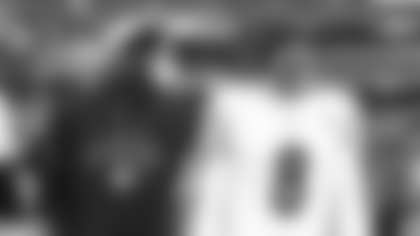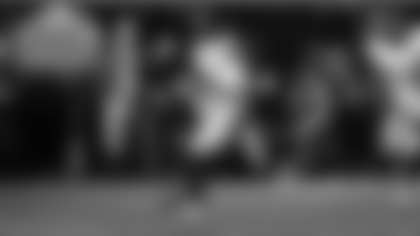Ready or not, here it comes:
• Most often, the bad ideas for position switches come from the fans. But not all of them.
• For me at least, it started with the brilliant idea of moving Ryan Shazier to safety. Then Jesse James to safety to increase the number of interceptions. Al Villanueva to wide receiver to juice the red zone touchdown percentage. Then more recently, Dan McCullers to fullback. And Zach Banner to fullback.
• But it hasn't only been fans who have wanted to tinker with players who have worked a long time at their crafts to ascend to the NFL level. There have been instances of NFL coaches going all mad scientist with some idea they had come to believe was going to change the fortunes of their team.
• As a disclaimer, the kinds of position switches that don't fit into this category are the ones made in an attempt to find a position for a player, or a spot on the team for a player who really didn't have one.
• Fitting into this category would be the moves of Carlton Haselrig from nose tackle to guard, and Al Villanueva from defensive line to offensive tackle.
• Haselrig was the six-time NCAA heavyweight wrestling champion the Steelers picked in the 12th round of the 1989 NFL Draft from Pitt-Johnstown, a college that didn't even have a football program. After seeing him struggle as a nose tackle, Chuck Noll decided the natural leverage Haselrig used as a champion wrestler could be put to good use on the offensive line. Haselrig was voted to the Pro Bowl in 1992 before having his football career sidetracked by a series of personal issues.
• Villanueva played both wide receiver and tight end at West Point, and then after honoring his commitment to the military he got around to giving professional football a try as an undrafted free agent defensive lineman with the Philadelphia Eagles. Spotted on the opposite sideline by Coach Mike Tomlin during a preseason game, the Steelers picked up Villanueva and taught him offensive tackle while he was on their practice squad.
• No, those aren't the kinds of position switches being dealt with here. These are the ones involving established NFL players, highly-drafted players who excelled at top college football programs, or guys drafted in the top half of the first round to be one thing only to be told they were going to be used as something else.
• Chronologically speaking, we begin in 1992. Bill Cowher was in his rookie season as the Steelers coach, and he had assembled a defensive staff that included Dom Capers as the coordinator, Marvin Lewis as the linebackers coach, and Dick LeBeau as the secondary coach.
• Besides Rod Woodson, the best defensive player Cowher was inheriting from Chuck Noll was outside linebacker Greg Lloyd, who in 1992 was a 27-year-old 3-4 outside linebacker coming off his first Pro Bowl season after posting eight sacks, one interception, and two fumble recoveries. The only problem was that when Cowher looked at Lloyd, he saw an inside linebacker in the version of the 3-4 he was going to put together for the Steelers.
• Lloyd resisted, and he didn't do it quietly. At 228 pounds, Lloyd contended he was too slight to be an inside linebacker at a time in the NFL where guys at that position often weighed 250 or more, and being inside would negate his quickness off the edge and make it more difficult to sack the quarterback. Lloyd's disinterest in the move to inside linebacker certainly was a factor in the move being scrapped before the start of the regular season, which was a lucky break for the Steelers.
• That's because in 1992, as the right outside linebacker, Lloyd was voted to his second straight Pro Bowl after a season in which he had one interception, forced five fumbles and recovered four, had 6.5 sacks and 96 tackles. Then in the next three seasons – 1993, 1994, 1995 – again as the right outside linebacker, Lloyd was voted first-team All-Pro after each one, and he totaled 314 tackles, 22.5 sacks, four interceptions, and 12 forced fumbles as he became the first Steelers player to perfect the sack-strip in which the defender attacks from the blind-side and chops at the ball in the quarterback's hand while making contact.
• The next example came a few seasons later, and while it involved the same position – outside linebacker – this time the player was Mike Vrabel and the Steelers defensive coordinator was Jim Haslett.
• A third-round pick in the 1997 NFL Draft, Vrabel was defined as a defensive end at Ohio State, but at about 250 pounds and based on how he was used by the Buckeyes, his position in the NFL was going to be as an outside linebacker in a 3-4 defense. And an injection of Vrabel's kind of production was just what the Steelers needed, because 1997 would turn out to be Lloyd's final season with the team.
• In 1996, Vrabel set a single-season Ohio State record with 13 sacks, and his 36 career sacks still ranks him No. 1 in school history in that category. In each of his final two college seasons, Vrabel was voted Big Ten Conference Defensive Lineman of the Year.
• But when he got to the Steelers, Carlos Emmons was the starter at right outside linebacker and Jason Gildon was the starting left outside linebacker, and rather than allow Vrabel to adapt to the NFL and then compete for one of those jobs, the Steelers started hunting for another position for him.
• First, Vrabel was asked to gain weight so he could play on the defensive line. Then, Vrabel was asked to lose the weight he gained so he could play outside linebacker. Then Haslett decided it would be a good idea to have Vrabel be an inside pass rusher in the dime defensive alignment, which put two defensive linemen flanked by two outside linebackers on the line of scrimmage in passing situations. At 245-250 pounds, Vrabel was aligned in a three-point stance in the middle of the line of scrimmage, which ended up accomplishing nothing except making it easier for opponents to run the ball between the tackles and frustrating Vrabel to the extent that he jumped at the chance to leave for New England via free agency after the 2000 NFL season.
• With the Patriots, Vrabel was put at outside linebacker and again was the kind of player he was in college. During his time in New England he had 48 sacks, 34 passes defensed, 11 interceptions, 13 forced fumbles, and 55 tackles for loss, while being voted first-team All-Pro in 2007 and helping the Patriots win three Lombardi Trophies.
• The final example to be cited here involves Minkah Fitzpatrick and how another team's coach came up with an idea that could be classified as the football version of turning a thoroughbred into a plow-horse.
• Before Brian Flores was hired to replace Adam Gase as the Miami Dolphins head coach, he worked in New England under Bill Belichick. Flores started there in 2011 as a defensive assistant, and he then served as the team's safeties coach from 2012-15, and then the linebackers coach from 2016-18.
• One of the key players Flores coached in New England, and one of the key players on Belichick's defenses was and continues to be Patrick Chung, a guy who would be described as a strong safety. Chung is asked to battle tight ends, to support the run, to be the kind of in-the-box safety who now would be described as a dime linebacker or a sub-package linebacker.
• Again, Chung is a good player, but splash is not his game and never has been. He never has been voted to a Pro Bowl, and for the 2019 Patriots defense that leads the NFL in takeaways, interceptions, and points allowed, Chung is a full-time starter but has no interceptions and two passes defensed. Devin McCourty, with five interceptions and a fumble recovery, is the Patriots defensive back who is most similar to Fitzpatrick. McCourty is Belichick's free safety.
• So when Flores took over the Dolphins job, he apparently was looking for his own Patrick Chung, and for some reason he decided the best man for that job was Minkah Fitzpatrick, the 11th overall pick of the 2018 NFL Draft. Why a coach would look at a player who had 24 passes defensed and nine interceptions, four of which he returned for touchdowns, in 42 college games, and see a hybrid linebacker is anyone's guess.
• And that "dispute" over how he was being used is what precipitated Fitzpatrick's request to the Dolphins to be traded, which is how he ended up with the Steelers, which is a big reason why the team that had eight interceptions in all of 2018 already has 14 through 10 games of 2019, with Fitzpatrick personally accounting for five in his eight games with the team.
• As a knowledgeable football guy once told me in all seriousness, "You always have a chance, because the other team has coaches, too."














